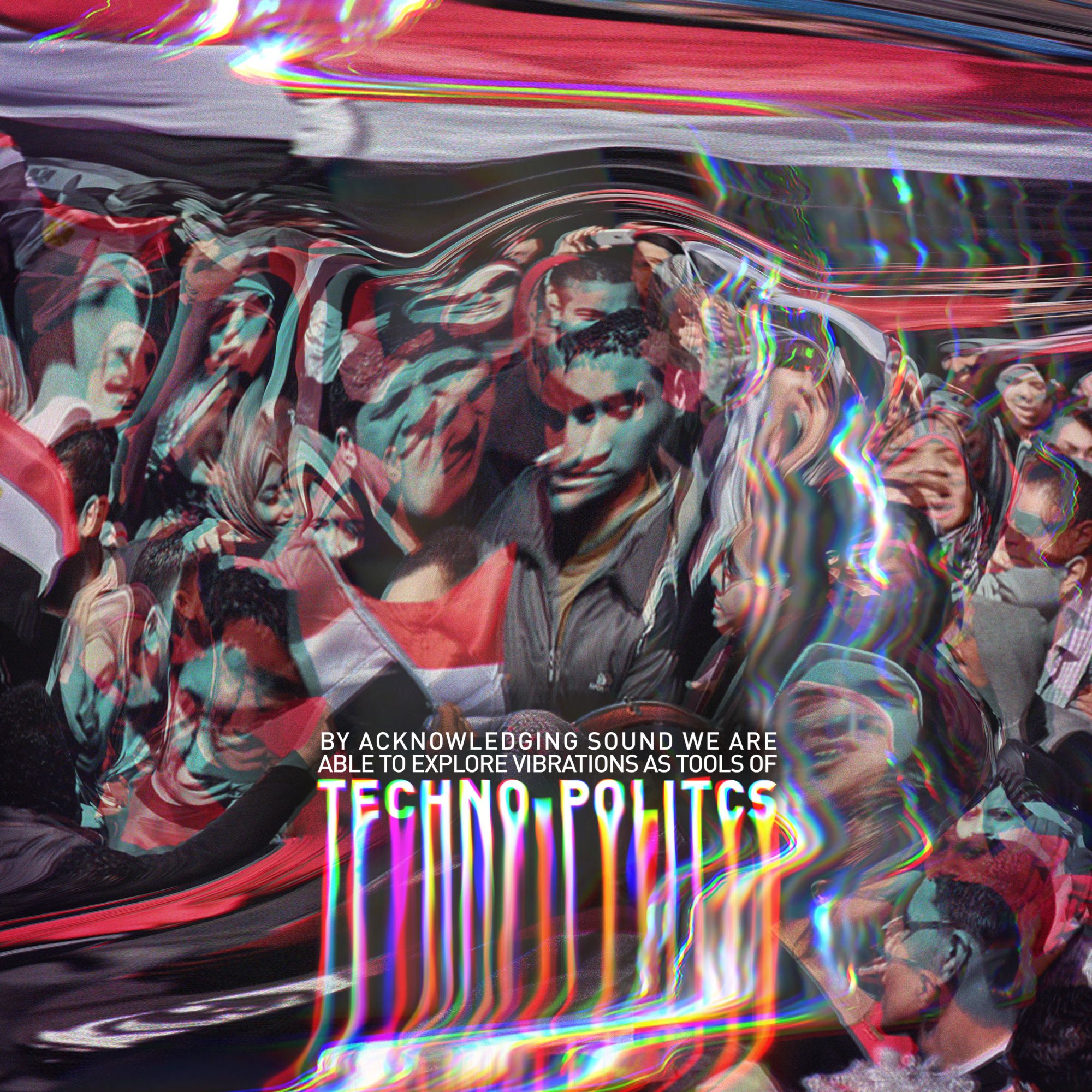Ghost City, Tear Gas, Novel Rhythm, Nowhere to Go
By thinking about and with sound, we experience the world through embodied practices. In her mesmerizing sonic essay based on field recordings in a protest-struck Cairo, our contributor asks: How are bodies, things, and cityscapes interconnected?
Ting, ting, ting, sonic bodies, beep, beep, beep… please wait while your transaction… Doot, doot, doot. Drrrrrrrrrrrrr. And the government is always NAGGING, NAGGing, NAgging. And you can even tell by their body language that they carry ahhh burden. Allaaah akbaaar… Horns, tuk-tuks, motorists. Ting, damtatamdam. Clinking of the gas man’s tools. Tatata. Beware. Paap, pu-pu-boom. Shootings. Do not care. Fuckfuckfuck, fuckin’ widda real. Aaahh, fuckin’ widda real. Tell me how you feel when you fuckin’ widda real? Ahh. Daddidadidaaadidaaa. Big brother. Swish, thith. Sky. Is. Enemy. Helicopter birds. Loud. Mahraganat. Sweating. Vibrational bodies. Forgetting. No. Yes. Dadoom. Stella. Dissonance. Escaping. Whirling. Dadooom. Blade-passing frequency. Sound of silence. Ousted. Curfew. Ghost city. Flight. Tear gas. Choking pain. Pull of suspicion. He took the bullet meant for me. Guilt. Shame on you. Massacre. Shootings. Sirens. Low-flying aircrafts. Novel rhythm. Nowhere to go. Metallic birds again, again, again. Anxiety-ridden bodies. Touched bodies. Crowded Cairo. Loud voice. SILENCE. Reorientation. Alienation. Sonic disciplining. Absence of sound. Loss of navigation. Vicious circles of uncertainty. Aural communication. Protesters. No. Irhal. Sonic enemy of silence. DADOOM. Poom, sthiiiiik, dadooom. Reverbation. Ahmed. Mohamad. Karim. Ibrahim. Abed. Hassan. Mahmood. Sherif. Said. Ali. Whispering. Names of prisoners. Sounds of the living dead. Moving voices. Aaaahaoh. Streets are talking to me. Ghost bodies. Desire to disappear in order not to disappear. Dadoom, schh, aeeehhh, hchmm, dadadadaaaa. Waiting. Tataatick, tichk, da, chch, krchkrch. Revolution of the poor is coming. dANG, DANG. Never. Forget. Chchhhhh. Tututut. Frequency. Amplitude. Beep, beep, beep… please wait while your transaction… Doot, doot, doot. Drrrrrrrrrrrrr. Fuckfuckfuck, fuckin’ widda real.
I am triggered by the vast potential of worlds that are still to be unlocked, attempting to spin new webs of thought spanning the globe. This specific piece takes us through the Cairo streets, where we hear sounds of various human actors, but also non-living actors. This phenomenon unlocks unfamiliar worlds and invites the listener to listen from sonic fragments, matter, spaces, and places since 2013 and onward. Consciously listening, attending to sounds is a political tactic, because listening alters the body of the listener (Labelle 2018). It is a method for transmission of sound knowledge and for novel ways of being in the world of self and others. Sound knowledge initiates a process of social change, even if we must linger in spaces of discomfort, in both the pain and praise of others (Kapchan 2016).
Thinking and speculating with sounds instead of about sounds produces new knowledge about the world and our understanding about us being-in-the-world, body-subjects, to use Merleau-Ponty’s (1968) terms, far beyond the Cartesian logic (dualist model of body and mind). We experience the world through embodied practices rather than through cognitive and linguistic models. By focusing on only our hearing, we learn to trust ourselves and unknown others. It instructs us to sonically sense the story of the aftermath of the «failed revolution» in Egypt and what happened to it after the disaster in 2013, as well as to experience matter, places, and spaces through the politics of the ear in relation to an imagined or rejected nation. We experience the world through embodied practices rather than through cognitive and linguistic models.
The sonic affects us, touches us, moves through our bodies and alters our emotions, vibration and rhythm. It allows us to reflect upon ways that the materiality of sound, the emotions connected to the sonic, the censorship of sound, or the propaganda with sound, help us understand (counter-) power, claims to authenticity, authority, resistance, and deviance. Our new sonic emotional knowledge opens common experiences and potential paths for change. By acknowledging sound, whose vibrations are material and can be measured as infrastructures, we are able to explore vibrations as sonic infrastructures, as tools of techno-politics.1
Sound Piece
My intention in the sound essay Affective Sonic Fragments in Sisi’s Egypt is to invite you to use several senses at the same time and to think with sound instead of about sound. I want to touch the relationally porous skin of your body and to move your sonic body through aural communication and let you sonically understand specific forces of sound. How do sonic vibrations mediate consciousness? How does sound shape/constrain the actions of individuals/groups? How can sound tell us more about being human and about imagination? How are bodies, things, and cityscapes interconnected? How do they produce sensations in relation to intense and slow times (temporality and frequency)? How will collective bodies of trauma, like the sonic bodies of Cairenes, but also in relation to the global body, navigate? How will they cross the street into the unknown future as one relational collective body? Is it possible to find stillness in the movement? The sonic body can act, tell a larger story, be evidence and be de/re-formed. The loud and silent body may also signify contradictions, since it is capable of both reaffirming and transforming forms of domination. By using the senses instead of words alone, one may be able to grasp what is beyond language in language.
- 1. Sonic infrastructures encompassing both audible spaces and matter and by new collective sound knowledge we are able to creates a dialogue with contemporary global struggles, even if autocratic regimes consciously produce and perform both concrete and symbolic sonic violence, where changes of rhythm and frequency are key.
List of References
The sound piece intimately communicates with Malmström’s book «The Streets Are Talking to Me: Affective Fragments in Sisi’s Egypt». It is co-produced with Desert Kites combines field recordings from multiple fieldworks in Cairo between 2012 and 2018 with music by Desert Kites, along with the Egyptian musician Mr Kordy’s (with his permission) composition Fuckin’ Widda Real (video directed by Raed Al Murish).
«Sonic Worlding» is a monthly Norient column. It invites writers and artists from all over the world to to think and speculate with and not only about music. Where most music writing treats music as something that can be categorised and placed in pre-determined boxes (personality cults, end-of-year lists, genres, origins, styles), «Sonic Worlding» is interested in the vast potential of rhythms, ideas, and worlds that are still to be unlocked, attempting to spin new webs of thought spanning the globe. Edited & curated by Norient editor Philipp Rhensius.
Biography
Biography
Published on December 20, 2022
Last updated on February 19, 2025
Topics
Why do people in Karachi yell rather than talk and how does the sound of Dakar or Luanda affect music production?
Music and art that dealing with the unfinished and undefined.
Place remains important. Either for traditional minorities such as the Chinese Lisu or hyper-connected techno producers.
About Tunisian rappers risking their life to criticize politics and musicians affirming 21st century misery in order to push it into its dissolution.
Does a crematorium really have worst sounds in the world? Is there a sound free of any symbolic meaning?
What is «Treble Culture»? How does what one hears affect what one sees?
Snap








